Work and Health Programme statistics to August 2020
Updated 26 November 2020
The latest release of these statistics can be found in the Work and Health Programme statistics collection.

This quarterly release of experimental statistics on the Work and Health Programme includes data up to August 2020.
Statistics covered in this bulletin include data covering the initial period of the coronavirus (COVID-19) pandemic. The measures taken during the pandemic have had an impact on the delivery of the WHP and on its performance in the most recent months reported in this release. The Department for Work and Pensions (DWP) has deployed a number of measures to deal with the unprecedented levels of demand on the department. DWP’s priority continues to be ensuring people get their benefit payments and support for those who need it the most, therefore there have been lower numbers of referrals to the WHP during this time. As face to face meetings were also suspended, DWP provided additional online signposting to the WHP, and enabled self-referrals from individuals who were eligible. Additionally, some employment sectors were unable to recruit and others saw substantial reductions in job opportunities.
The next release will be on 25th February 2021.
We are seeking user feedback on this HTML version of the statistical bulletin which replaces the PDF version. Send comments to: stats-consultation@dwp.gov.uk.
1. Introduction
The Work and Health Programme (WHP) was launched in England and Wales between November 2017 and April 2018 predominantly to help people who are disabled, as well as the long-term unemployed or those in the Early Access group to enter into and stay in work.
People are referred by Jobcentres to work with organisations known as providers from the public, private and voluntary sectors. Providers are paid a service delivery fee and outcome-related payments when a person reaches either:
- a specified level of earnings once in employment
- 6 months of being in self-employment
2. Main Stories
Statistics covered in this bulletin include data covering the initial period of the coronavirus (COVID-19) pandemic. The measures taken during the pandemic have had an impact on the delivery of the WHP and on its performance in the most recent months reported in this release. DWP have deployed a number of measures to deal with the unprecedented levels of demand on the department. DWP’s priority continues to be ensuring people get their benefit payments and support for those who need it the most, therefore there have been lower numbers of referrals to the WHP during this time. As face to face meetings were also suspended, DWP provided additional online signposting to the WHP, and enabled self-referrals from individuals who were eligible. Additionally, some employment sectors were unable to recruit and others saw substantial reductions in job opportunities.
During the UK-wide lockdown starting in March 2020, the face-to-face delivery of the WHP by providers was suspended. This meant that providers took alternative routes to service delivery including digital options and providing a telephony service to ensure support continued. This context should be considered when considering the success or timeliness of outcomes from the programme with regard to this period.
This release includes statistics on the performance of WHP for the first time. See the section titled ‘Performance levels’ below to see how the actual number of job outcomes compares against the expected number of job outcomes.
The statistics show:
- 74% of all individuals referred have started on the WHP by August 2020
Of all people starting since the Work and Health Programme’s inception:
- 73% are from the Disability group
- 62% are male
- 30% have achieved their first earnings from employment
- 16% have achieved a job outcome
Since the WHP began there have been:
- 160,000 individuals referred
- 120,000 starts
- 35,000 first earnings from employment
- 19,000 job outcomes
How many people have started on the WHP?
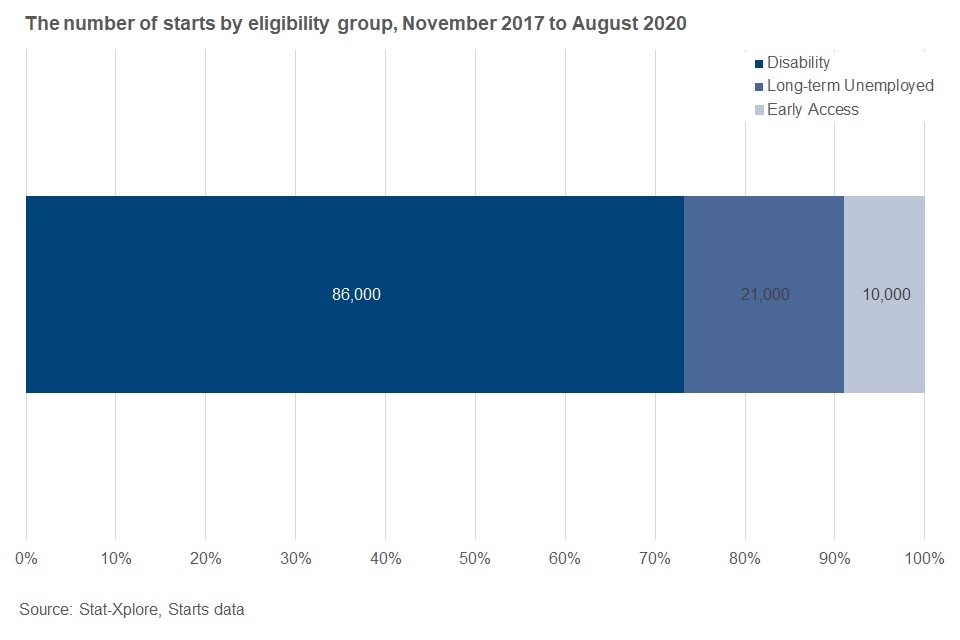
From all people starting on the WHP, 86,000 are in the Disability group (73%), 21,000 are in the Long-term Unemployed group (18%) and 10,000 are in the Early Access group (9%).
120,000 individuals referred are from the disability group (74%). There are 25,000 individuals in the Long Term Unemployed group (16%) and 15,000 in the Early Access group (10%).
For full data see Table 1.1 of the tables accompanying this release.
Who is achieving a job outcome on the WHP
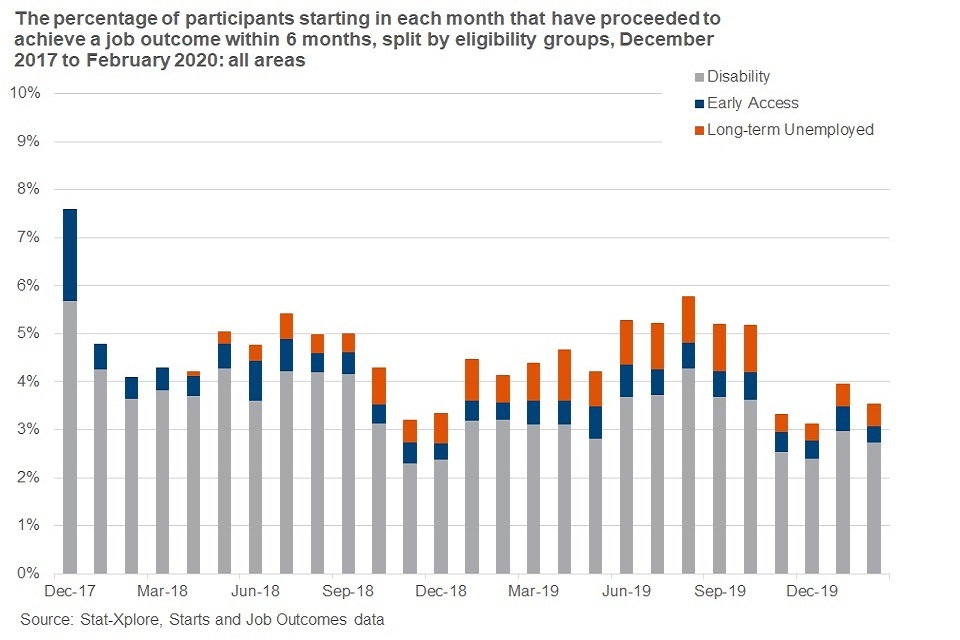
As the Disability group accounts for the largest number of starts, they also make up the majority of job outcomes (76%). The Early Access group and Long-term Unemployed groups account for 24% of the total number of job outcomes. From 6 months after starting the programme to 12 months after starting the programme, the percentage of outcomes triples in nearly all monthly cohorts.
For full data see Table 1.6 of the tables accompanying this release.
Of those starting in February 2020, 4% have gone on to achieve a job outcome within 6 months.
Proportion of those starting on the WHP who have achieved a job outcome from December 2017 to February 2020:
- 17% of the Early Access group
- 16% of the Disability group
- 13% of the Long-term Unemployed group
3. What you need to know
Definitions
The following definitions are used in the statistics:
Participants
The WHP, launched in England and Wales between November 2017 and April 2018, aims to provide support to help people find and keep a job. It is available to the following 3 eligibility groups:
- Disability group – voluntary for disabled people as defined in the Equality Act (2010). This is the main group that the WHP is aimed at.
- Early Access group – voluntary and aimed at people who may need support to move into employment and are in one of a number of priority groups (for example homeless, ex-armed forces, care leavers, refugees).
- Long-term Unemployed group – mandatory for Jobseeker’s Allowance (JSA) or Universal Credit (UC) claimants who have reached 24 months of unemployment.
WHP participants may or may not be in receipt of certain means-tested benefits such as JSA, UC, Employment and Support Allowance (ESA) and Income Support (IS). Alternatively, participants can be signposted to WHP by approved organisations (for example, community and voluntary groups).
Providers
WHP is delivered across England and Wales by 5 providers across 6 areas, known as Contract Package Areas (CPAs). In some CPAs, the government has designed WHP in consultation with Local Enterprise Partnerships and city regions (partnerships between local authorities and businesses). These are known as Devolved Deal Areas (DDA). These areas have a strong voice in the ongoing monitoring of the performance on the programme in their areas.
In London and Greater Manchester, where devolution deals are in place, the WHP is commissioned and contract managed by the local authorities, known as Local Government Partners (LGP), who are match-funded by the European Social Fund (ESF). See the background information note for more information.
For more information about this see Table 2.2 of the tables accompanying this release.
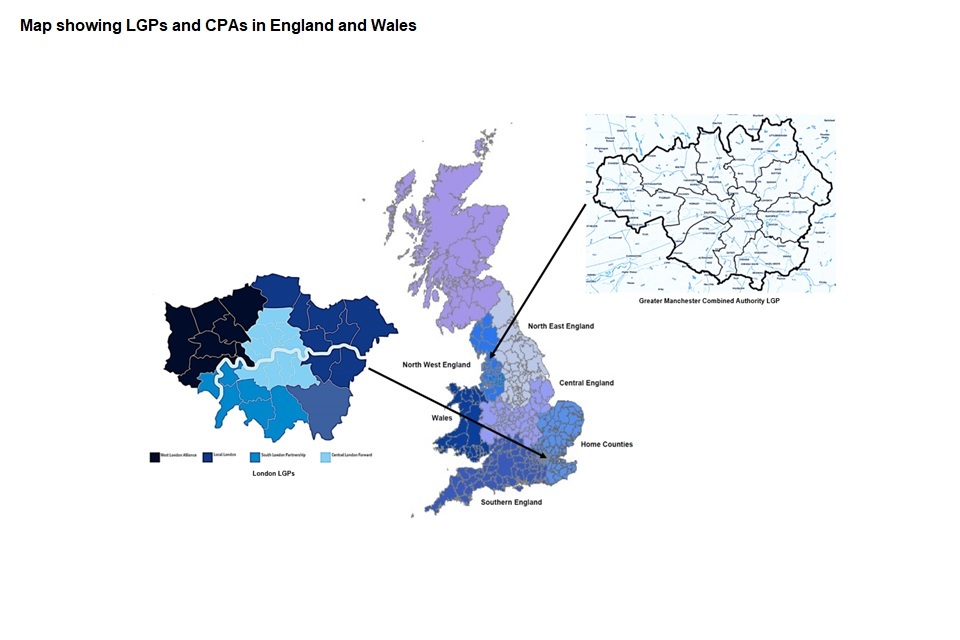
The administration of the WHP is split into multiple areas within England and Wales (CPAs). England is split up into 5 areas, whilst Wales is a single area. Furthermore, the WHP is handled by LGPs within London and Manchester. For Manchester this is considered a unitary area, whereas London is split up into 4 separate areas (West London, Central London, South London and Lower London).
Referrals
Work coaches in Jobcentres will send details of a person wanting to join WHP to a provider. When a provider acknowledges the referral and contact has been established with the participant, this is called a referral. WHP participants can be referred more than once. Figures presented in this publication do not include cancelled or rejected referrals.
Individuals referred
As one individual can have multiple referrals, individuals referred is the number of individual people referred. This means only the first referral per person is counted.
Starts
A start on the programme is recorded when a WHP participant attends the initial face-to-face meeting with the provider. During the COVID-19 period (ongoing), these meetings are held digitally. The vast majority of starts should take place within 15 working days, although starts outside this window may occur if the customer does not attend the initial meeting within this time frame.
Cohort
A group of participants who all start on the WHP in the same month.
First earnings from employment
The point at which a participant achieves their first earnings from their first employment whilst on the programme. A participant may not necessarily go on to achieve a job outcome. Statistics on first earnings from employment do not include earnings from self-employment.
Job outcomes
A provider is classed as achieving a job outcome when a participant reaches either:
- a specified level of earnings once in employment (which varies across the different areas – see background information note for details)
- 6 months of being in self-employment
The earnings threshold for a job outcome for the National WHP and the majority of LGPs is 16 hours per week for 26 weeks at the National Living Wage, however the threshold for the West London Alliance is the same number of hours but at the London Living Wage and the Greater Manchester Combined Authority at the Real Living Wage.
Read the background information note for further information on WHP policy and definitions.
Expectations
The expectations used in the WHP statistics are the expected number of job outcomes for the programme either as a whole, split by eligibility groups or split by providers. For more information on the background to these expectations and to understand how they were created, see our background information note. Users can interpret these as the number of job outcomes anticipated when the WHP was rolled out.
Timeline of WHP progress

Referrals to the Early Access and Disability groups began in November 2017, and in March 2018 the WHP became available to all areas of the country. Long Term Unemployed referrals began in April 2018.
Lockdown measures due to the coronavirus (COVID-19) pandemic were implemented in April 2020. During the UK-wide lockdown starting in March 2020, the face-to-face delivery of the WHP by providers was suspended. This meant that providers took alternative routes to service delivery including digital options and providing a telephony service to ensure support continued. This context should be considered when considering the success or timeliness of outcomes from the programme with regard to this period.
4. Joining the Work and Health Programme
The number of monthly starts increased to a peak of 5,600 in March 2019 and remained relatively stable, until a decrease was seen in the months impacted by the coronavirus (COVID-19) pandemic.
Since the start of the programme, within England and Wales, there have been a total of:
- 190,000 referrals (this includes individuals who are referred multiple times)
- 160,000 individuals referred (unique referrals so each individual only counted once)
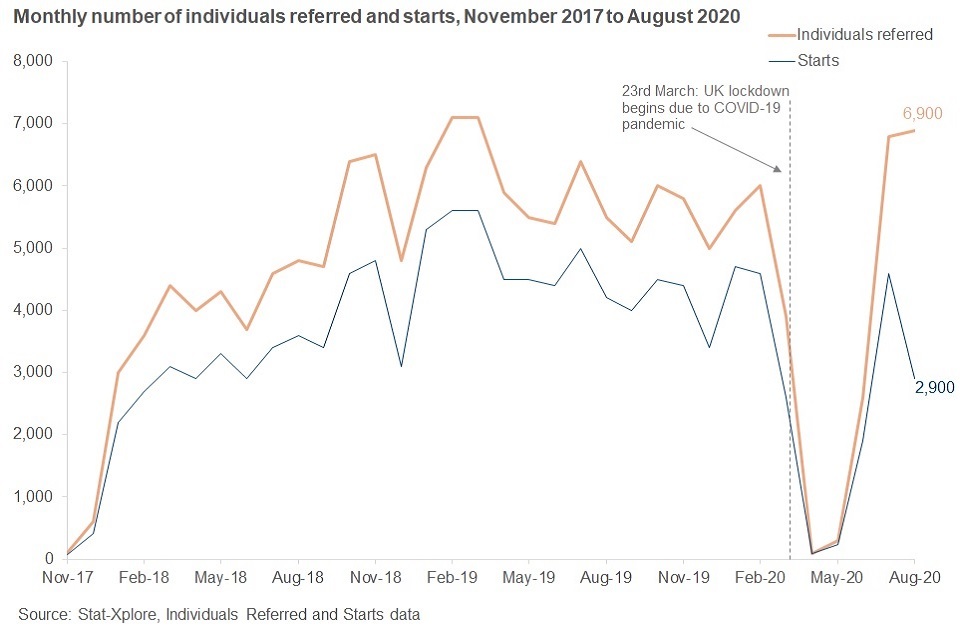
Please note in the May 2020 publication, methodology was improved to more accurately record the number of starts. We now account for the 15 days allowed after referrals to input start activity therefore the most recent month of starts data (August 2020) is incomplete.
The total number of monthly individual referrals and starts was on an upward trend from March 2018 (when the programme was available to all areas of the country). Referrals from the Long-term Unemployed group started in April 2018, with monthly starts and individual referrals reaching a peak in March 2019.
Following a decrease in April 2020 and May 2020, individuals referred and starts increased in the subsequent months. The drop in referrals and starts between April and May 2020 coincides with the COVID-19 pandemic and UK-wide lockdown.
During the coronavirus (COVID-19) pandemic DWP have deployed a number of measures to deal with the unprecedented levels of demand on the department. DWP’s priority continues to be ensuring people get their benefit payments and support for those who need it the most, therefore there have been lower numbers of referrals to the WHP during this time. As face to face meetings were also suspended, DWP provided additional online signposting to the WHP, and enabled self-referrals from individuals who were eligible.
Overall, the proportion of individuals referred that have started is 74%.

On average, across the duration of the WHP:
- 73% of starts come from the Disability group.
- 18% of starts come from the Long-term Unemployed group
- 9% of starts come from the Early Access group
In the latest month, August 2020:
- 86% of starts were from the Disability group
- 12% of starts were from the Early Access group
- 2% of starts were from the Long-term Unemployed group
For more information see Table 1.1 of the tables accompanying this release.

Table 1: Number of referrals and starts by area, from November 2017 to August 2020 by order of rollout (earliest listed first).
| Area | Provider | Date of Rollout | Referrals | Individuals referred | Starts | % of starts to individuals |
|---|---|---|---|---|---|---|
| North West | Ingeus | 27th November 2017 | 15,000 | 12,500 | 9,500 | 76% |
| Wales | Remploy | 1st December 2017 | 11,200 | 9,900 | 7,800 | 79% |
| Central | Shaw Trust | 15th January 2018 | 25,300 | 20,400 | 15,400 | 75% |
| North East | Reed In Partnership | 15th January 2018 | 33,000 | 29,100 | 22,400 | 77% |
| Southern | Seetec Pluss | 15th January 2018 | 24,000 | 20,400 | 15,000 | 74% |
| Home counties | Shaw Trust | 15th January 2018 | 15,300 | 12,800 | 9,800 | 76% |
| Greater Manchester Combined Authority | Ingeus and The Growth Company | 29th January 2018 | 19,600 | 16,200 | 11,700 | 73% |
| West London Alliance (WL) | Shaw Trust | 26th February 2018 | 9,900 | 8,200 | 5,500 | 67% |
| Central London Forward (CL) | Ingeus | 1st March 2018 | 19,700 | 15,800 | 10,200 | 65% |
| South London Partnership (SL) | Reed In Partnership | 1st March 2018 | 4,800 | 4,100 | 2,700 | 66% |
| Local London (LL) | Maximus | 1st March 2018 | 11,100 | 9,700 | 7,400 | 76% |
Source: WHP statistics data tables.
For full data see Table 2.1 and 2.2 of the tables accompanying this release. In this figure, referrals, individuals referred and starts are rounded to the nearest 100. See the background information note for maps of Greater Manchester and London LGP areas.
The WHP has been available to all areas since March 2018. Up until August 2020, 74% of individuals referred have started on the programme. Figures vary across areas due to size and when service rolled out, however cumulatively, the highest rate of individuals referred to starts is in Wales (79%) and the lowest is in Central London (65%).
5. First earnings from employment and job outcomes from the Work and Health Programme

Overall, 69% of the individuals referred by February 2020 have started the programme, whereas 31% have not; this may, for example, be due to the participant not attending their initial meeting with the provider.
Of the individuals who have started the programme so far, 16% have reached the job outcomes earnings threshold or 6 months of being in self-employment by August 2020. Participants who started the programme earliest have seen the highest level of outcomes as they have longer to reach the earning threshold or 6 months of being in self-employment.
Of the 84% of participants who have started but not reached a job outcome by February 2020, some of these participants have only had 6 months to achieve an outcome to date, so may yet go on to achieve a job outcome still.
Referrals after February 2020 are not presented, as it is unlikely these participants have had enough time and support on the programme to reach the job outcomes earnings threshold (which varies across the different areas) or 6 months in self-employment. Those who were referred before February 2020 have been engaged with the programme for longer and have received more support making job outcomes more likely.
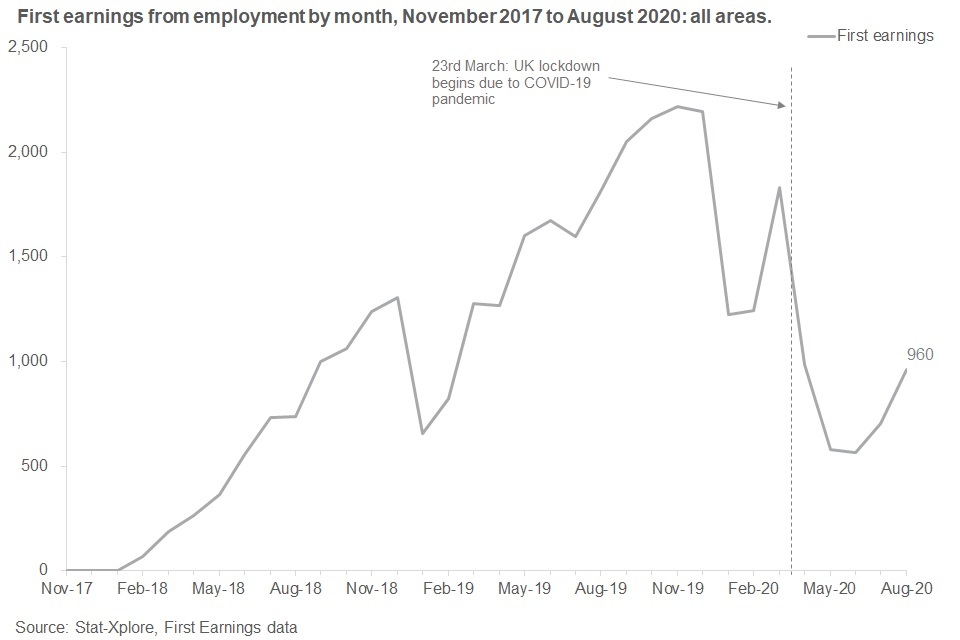

First earnings in employment is the point at which a participant achieves their first earnings from their first employment while on the programme. Subsequent employments are not included in the first earnings statistics.
February 2018 saw the first participants achieve first earnings from employment. In March 2018, the first participants reached the job outcomes earnings threshold or 6 months of being in self-employment.
As of August 2020, 35,000 participants have achieved first earnings from employment, 960 of these in the most recent month. Over the same time period 19,000 participants have reached the job outcome earnings threshold or 6 months of being in self-employment, 720 of these in the most recent month.
For full data see Table 1.4 of the tables accompanying this release.
Participants leave the program by either:
- achieving a job outcome
- being on the program for a full 21 months
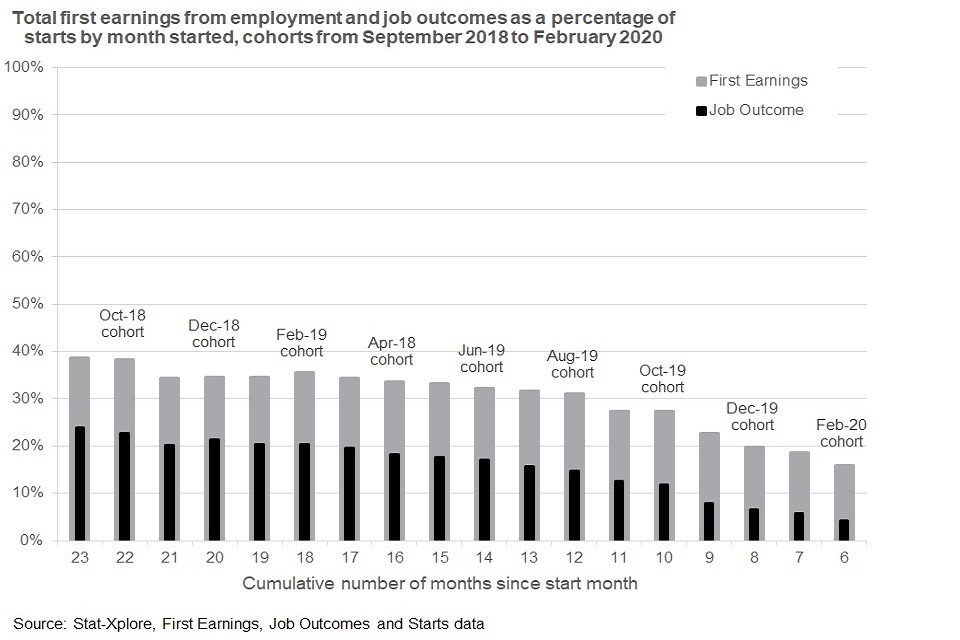
For full data see Table 1.3a and 1.3b of the tables accompanying this release.
Figures suggest that while not everyone goes on to achieve a job outcome, a higher proportion of people on the WHP have earned from employment while on the programme than have gone on to achieve an actual job outcome. Note that the first earnings in employment figures do not include those in self-employment.
First earnings from employment - standardised monthly performance measure at 6 and 12 months
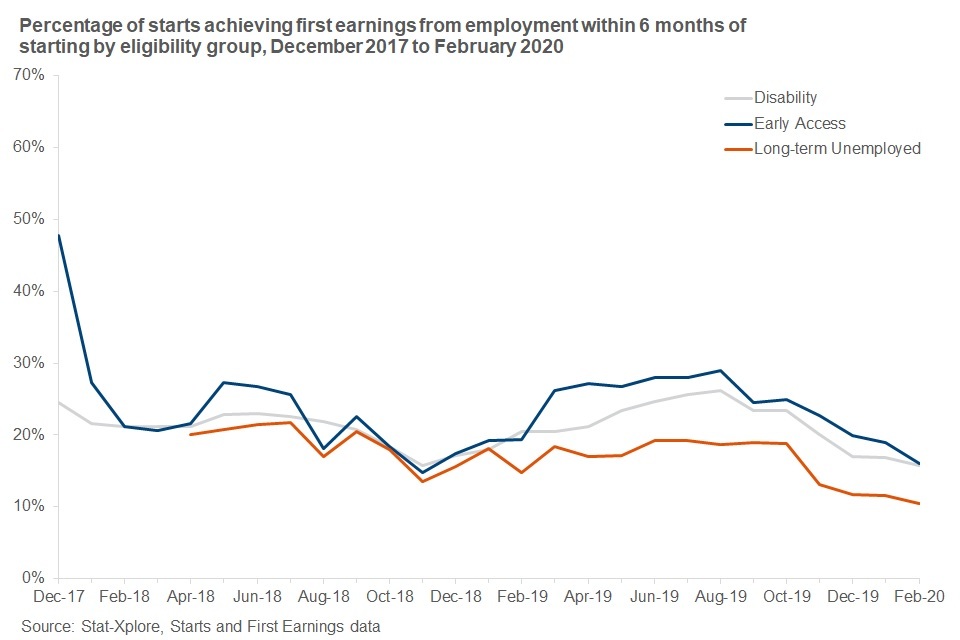
For full data see Table 1.2a of the tables accompanying this release.
The individual eligibility groups broadly mirror the same pattern. More recent start months are more likely to report lower levels of first earnings from employment and job outcomes as participants have not had as much time on the programme.
Over time, the proportion of participants achieving first earnings from employment within 6 months of starting the programme has ranged between:
- 16% and 26% for those from the Disability group
- 15% and 48% for those from the Early Access group
- 13% and 22% for those from the Long-term Unemployed group
Referrals for the Long-term Unemployed group began in April 2018, therefore there are no job outcomes for Long-term Unemployed cohorts starting before this date.
The Early Access group shows more change in percentages over time due to lower volumes of starts and first earnings from employment. This is most apparent for the December 2017 cohort.
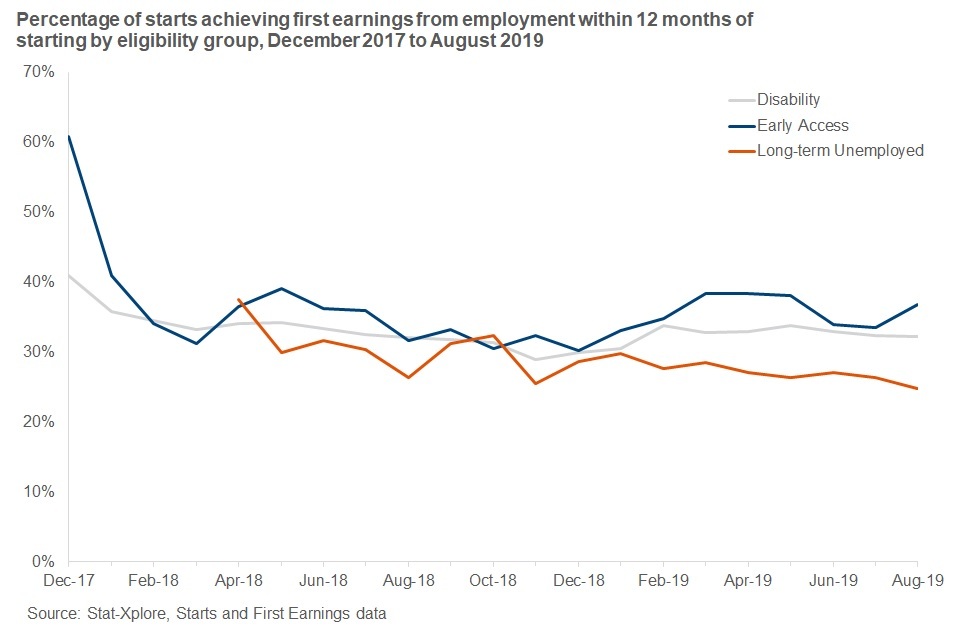
For full data see Table 1.2a of the tables accompanying this release.
Over time, the proportion of first earnings from employment achieved within 12 months of starting the programme has ranged between:
- 29% and 41% for those from the Disability group
- 30% and 61% for those from the Early Access group
- 25% and 38% for those from the Long-term Unemployed group
The proportion of first earnings from employment achieved by the Disability group within 12 months closely mirrors the total number of first earnings from employment achieved within 12 months of starting.
The Early Access group shows more change in percentages over time due to lower volumes of starts and first earnings from employment. This is most apparent for the December 2017 cohort, where at the start of the WHP, volumes were particularly low.
The Long-term Unemployed group began accepting referrals in April 2018, therefore there are no first earnings before this point.
Job Outcomes - standardised monthly performance measure at 6 and 12 months
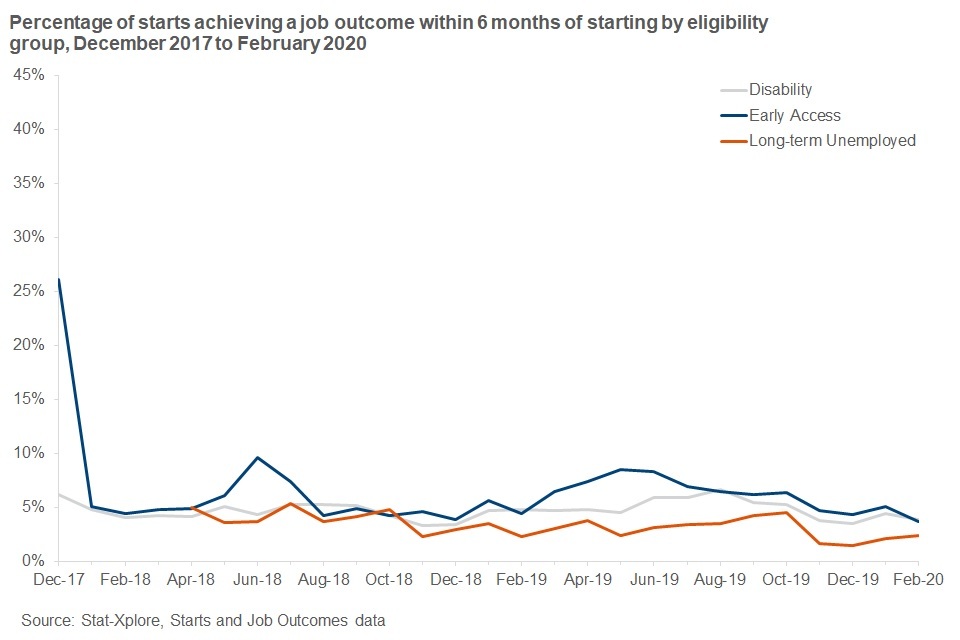
For full data see Table 1.2b of the tables accompanying this release.
Over time, the proportion of job outcomes achieved within 6 months of starting the programme has ranged between:
- 3% and 7% for those from the Disability group
- 4% and 26% for those from the Early Access group
- 1% and 5% for those from the Long-term Unemployed group
The Early Access group shows more change in percentages over time due to lower volumes of starts and job outcomes. This is most apparent for December 2017 and June 2018 cohorts.
The Long-term Unemployed group began accepting referrals in April 2018, therefore there are no outcomes before this point.
The measure of participants in employment within 6-months of starting to WHP does not allow much time for participants to achieve their job outcome. Therefore, the proportion of claimants achieving a job outcome within 12 months of starting provides a clearer picture.
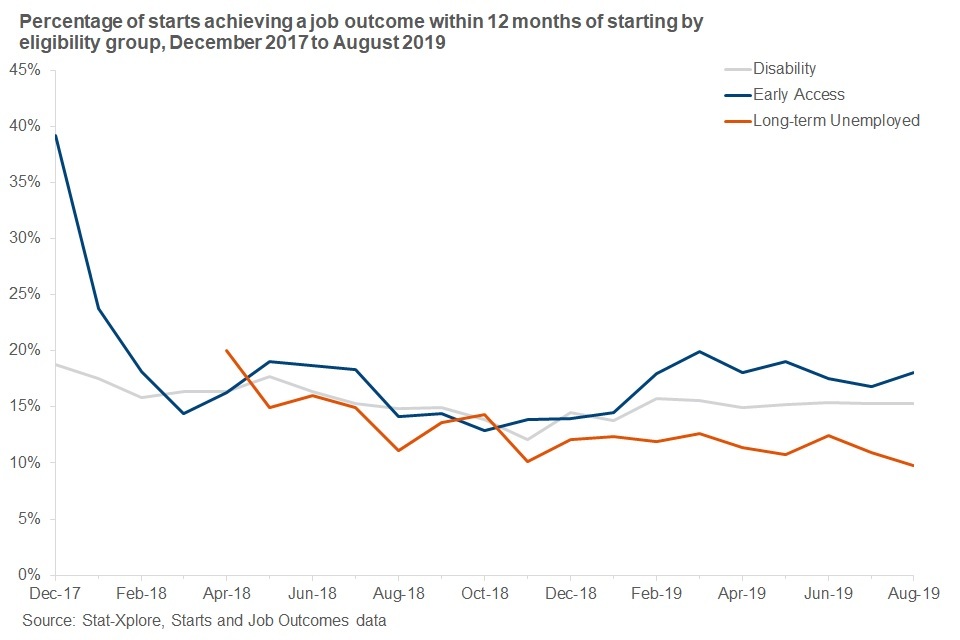
For full data see Table 1.2b of the tables accompanying this release.
Over time, the proportion of job outcomes achieved within 12 months of starting the programme has ranged between:
- 12% and 19% for those from the Disability group
- 13% and 39% for those from the Early Access group
- 10% and 20% for those from the Long-term Unemployed group
The Early Access group shows more change in percentages over time due to lower volumes of starts and job outcomes. This is most apparent for the December 2017 cohort.
As the Long-term Unemployed group only began accepting referrals in April 2018, there are no outcomes before this point.
6. Demographics of the Work and Health Programme

Overall starts on WHP:
- 13% are aged between 18 and 24
- 76% are aged between 25 and 59
- 11% are age 60+
Overall job outcomes on WHP:
- 15% are aged between 18 and 24
- 78% are aged between 25 and 59
- 6% are age 60+
The majority of all starts and job outcomes come from the 25 to 59 age group. This is to be expected as WHP is aimed at working age participants.
West London has the highest proportion of 25 to 59 year olds starting the programme (82%).
Proportions of job outcomes for the age groups follow the same trend as the proportions of starts. The highest proportion of 18 to 24 year olds achieving job outcomes on the programme is in The Home Counties (18%), while the highest proportion of 25 to 59 year olds achieving job outcomes on the programme is in West London (87%).
For further age breakdowns see Table 3.1a, 3.1b and 3.2 of the tables accompanying this release
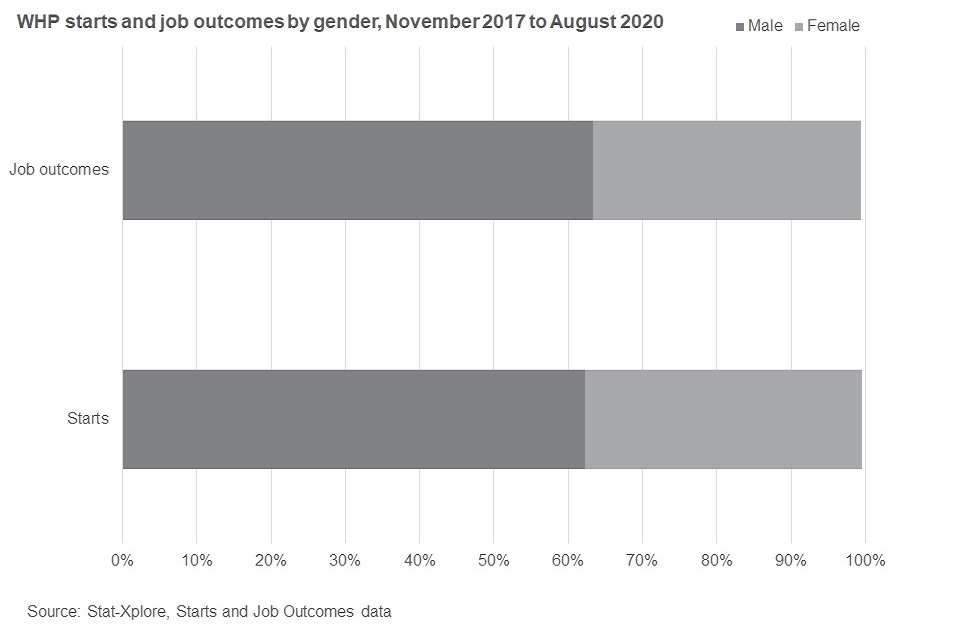
Males have accounted for the majority of starts to the programme (62%) compared to females (37%) and also account for the higher proportion of job outcomes (63%) compared to their female counterparts (36%). Although there is a difference in WHP participation by gender, rates of outcomes for males and females are broadly comparable. 16% of all males who have started the programme have gone on to achieve a job outcome, whilst 15% of all females who have started the programme have gone on to achieve a job outcome.
For full data see Table 1.5, 3.3 and 3.4 of the tables accompanying this release
7. Performance levels
Expectations
The expectations used in the WHP statistics are the expected number of job outcomes for the programme either as a whole, split by eligibility groups or split by providers. For more information on the background to these expectations and to understand how they were created, see our background information note. Users can interpret these as the number of job outcomes anticipated when the WHP was rolled out.
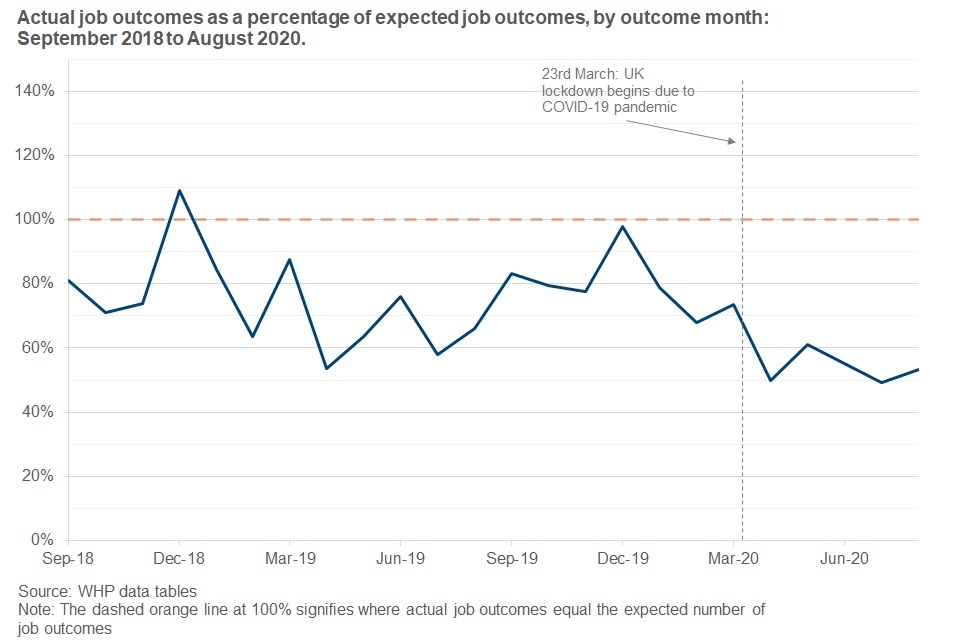
Nationally, overall performance of actual job outcomes against expected job outcomes fluctuates between 49% and 109% across the period September 2018 to August 2020. Job outcomes are measured by outcome month. For example, the 81% figure for September 2018 indicates that, across all cohorts combined, the actual number of job outcomes for September 2018 was 81% of the expected number of job outcomes for this month.

From the underlying raw number of actual vs expected job outcomes, it can be seen that the actual number of job outcomes shows a downward trend since December 2019. Over the same period, the expected number of job outcomes continues to increase, but at a decreased rate. This explains why the proportion of actual against expected job outcomes drops for this period.
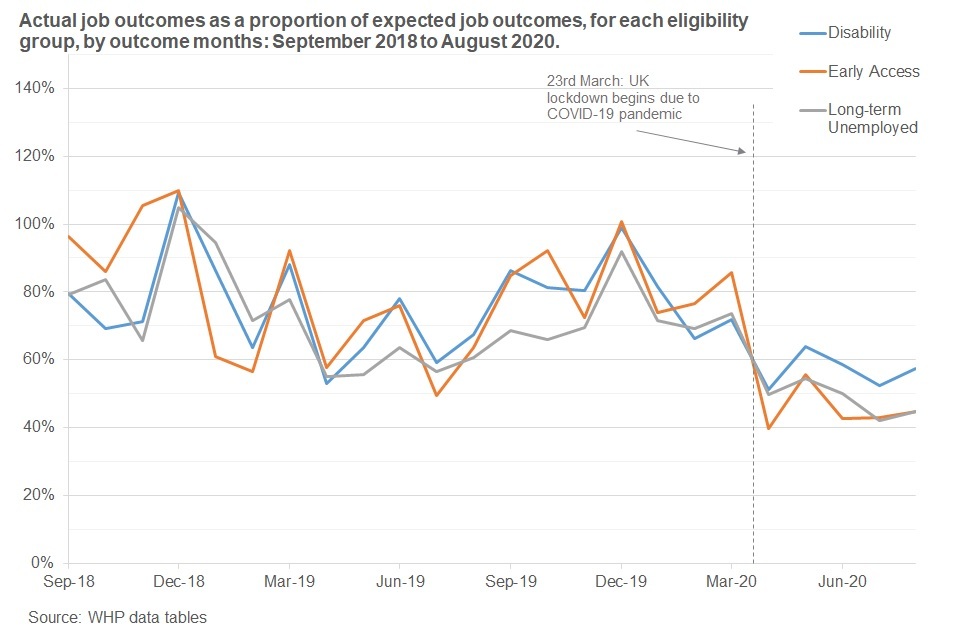
Nationally the 3 eligibility groups perform similarly. This suggests that the WHP achieves a similar proportion of expected outcomes for each eligibility group, taking into account the respective sizes of the groups. There is a lot of volatility on a month-to-month basis.
Provider context
There are key contextual differences to take into account between providers and Local Government Partners (LGPs). Participants must earn above a fixed threshold to achieve a job outcome through any provider nationally or in an LGP area. However, the thresholds used by the Greater Manchester Combined Authority (GMCA) and West London Alliance are greater than those used by other LGPs and by the national providers of the WHP. LGPs, as solely urban areas, have different demographics to Contract Package Areas (CPAs). Therefore, the demographics of eligible cohorts may be different to those of the national CPAs. LGP services started about four months after the national CPAs.
LGPs have also secured extra funding from the European Social Fund to increase participant numbers. This is not the case for national WHP providers. Actual job availability in different areas does not necessarily scale in line with the increase in participant numbers. More detail explaining these principles, their effects and other important contextual information may be found in our background information note.
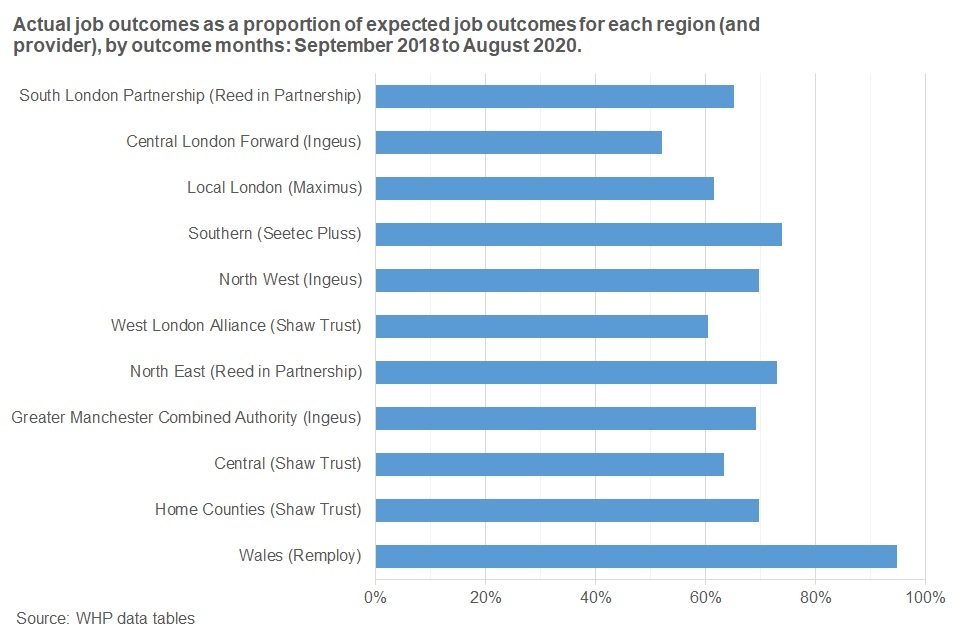
Across all regions and providers, performance of actual job outcomes has been between 52% (Central London Forward, Ingeus) and 95% (Wales, Remploy) of the expected number of outcomes, when summed across period September 2018 to August 2020.
Users should take into account the WHP is delivered across England and Wales by 5 providers across 6 areas, known as Contract Package Areas (CPAs). However, in London and Greater Manchester, where devolution deals are in place, the WHP is commissioned and contract managed by the local authorities, known as Local Government Partners (LGP). As a result, comparisons between regions should be made with great care and the contextual differences between CPAs and LGPs should be considered. See the background information note for more information.
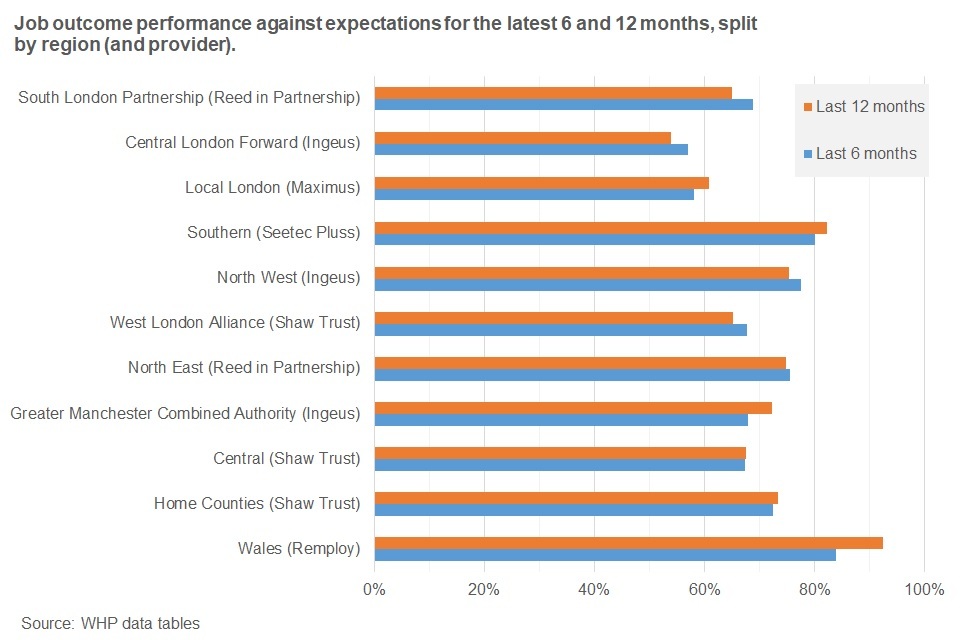
Performance over the latest 6 and 12 months for each provider is in line with performance over the 24-month period September 2018 to August 2020.
8. About these statistics
This statistical summary gives an overview. Key points and trends are presented using charts and commentary. The information underlying the charts is available as supporting tables.
In line with our publications strategy, we aim to release additional breakdowns in future publications.
Details will be announced, in advance via StatsUserNet and the DWP statistics calendar.
Rounding
Volumes and amounts have been rounded as detailed in the background information note. Percentages are calculated using numbers prior to rounding and rounded to the nearest whole percentage point.
Experimental statistics
Experimental statistics are Official Statistics which are published in order to involve users and stakeholders in their development and as a means to build in quality at an early stage. All Official Statistics should comply with the UK Statistics Authority’s Code of Practice for Statistics which promotes the production and dissemination of official statistics that inform decision making.
Where to find out more
Read the WHP background information note for more Information about the statistics.
The Work and Health Programme provider guidance is used by programme providers.
Information on the Work Programme, a programme which aimed to get unemployed people into sustained employment can be found in the collection of Work Programme statistics.
Information on Work Choice, a programme which aimed to help disabled people find, keep and progress in a job, can be found in the collection of Work Choice statistics.
Information on Specialist Employability Support, a voluntary programme which is aimed at helping disabled people with complex barriers that other support is not suitable for to find a job, can be found in the collection of Specialist Employability Support statistics.
Information on the Access to Work provision, which is aimed to support people who have a disability or long-term health condition start or stay in work, can be found in the collection of Access to Work statistics.
Users can also produce their own tables and access demographic breakdowns using StatXplore.
Contact information and feedback
Authors: Jonathan Thompson, Jen Machin and Joseph Glynn
Lead Statistician: Tracy Hills
For more information on WHP statistics, contact the EPASS Team.
DWP would like to hear your views on our statistical publications. If you use any of our statistics publications, we would be interested in hearing what you use them for and how well they meet your requirements. Please send your comments by email to: stats-consultation@dwp.gov.uk.
Users can also join the ‘Welfare and Benefit Statistics’ community at StatsUserNet. DWP announces items of interest to users via this forum, as well as replying to users’ questions.
